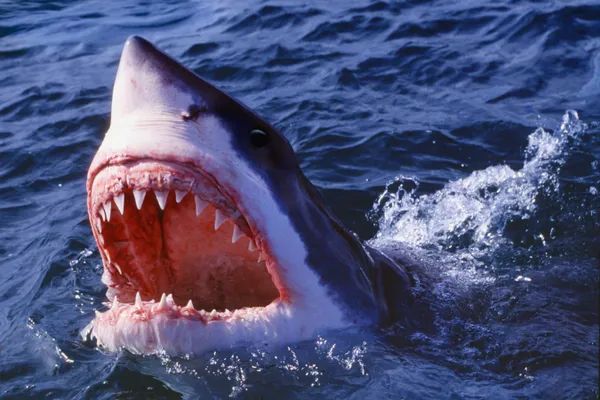Terror Returns to the Deep: Real-Life “Jaws” Fear as Great White Sharks Surge Along New England Coast
The haunting shadow of Jaws has returned — this time, not on the silver screen, but in the chillingly real waters of New England. Once considered relatively safe from the ocean’s most feared predator, the Atlantic coastline of the northeastern United States is now witnessing a dramatic and unprecedented surge in great white shark activity. The scenes unfolding there could have been ripped straight from Steven Spielberg’s 1975 masterpiece that terrified audiences worldwide.
In recent years, scientists and marine officials have documented an alarming rise in shark sightings across the region. According to the Maine Department of Marine Resources (DMR), at least 93 great white sharks have been identified along the coast between 2020 and 2024 — a number that experts describe as “astonishingly high” for what was once considered low-risk territory. Nearby regions like Halifax, Nova Scotia, and the Gulf of Maine have reported similar spikes, with shark detections increasing two to four times over the past few years.
Marine biologists believe this resurgence is being driven by several interlocking environmental shifts. Warmer ocean temperatures, changes in prey migration, and the booming population of seals — a favourite meal for great whites — are creating ideal hunting conditions. As seals crowd the coastlines of Cape Cod and Maine, the predators are following, leading to encounters disturbingly close to popular beaches.
Dr. Greg Skomal, a renowned shark expert from Massachusetts, describes it as “a perfect storm.” He explains that climate change has not only warmed the Atlantic but also altered the behaviour of both sharks and their prey. “We’re essentially seeing the ecosystem rebalance itself,” he said. “But for beachgoers, that balance can look like something straight out of a horror film.”
The eerie similarities to Jaws have not gone unnoticed. In the movie, the fictional Amity Island — based on Martha’s Vineyard, Massachusetts — is terrorized by a great white shark, forcing the small beach town into panic. Nearly fifty years later, the same coastlines are now facing their own version of that nightmare. Local authorities have been forced to install emergency response kits, enhance lifeguard training, and deploy drone patrols to monitor shark activity in real time.
While experts insist that actual shark attacks remain extremely rare, public anxiety is rising. Beachgoers are reporting more fin sightings, and the presence of shark warning flags — once unheard of in New England — is becoming a regular sight. The emotional impact is undeniable: families hesitate before entering the water, and lifeguards are trained to respond to what they call “Jaws scenarios.”
The spike in shark activity is also transforming the tourism landscape. Some towns, such as Cape Cod, have leaned into the phenomenon, offering shark tours and awareness programs. Others, however, fear the economic blowback of terrified visitors steering clear of the beaches. “We don’t want panic,” says one local official, “but we can’t pretend the danger doesn’t exist.”
Experts advise beach users to remain alert rather than afraid. Swimmers are urged to stay close to shore, avoid waters near seal colonies, and refrain from swimming at dawn or dusk — peak feeding times for sharks. Authorities also stress the importance of remaining calm if a shark is spotted: “Leave the water slowly and avoid splashing,” reads one of the new safety posters plastered across Massachusetts beaches.
Despite the tension, marine conservationists remind the public that these predators are vital to ocean ecosystems. Great white sharks, though terrifying in reputation, play a crucial role in maintaining healthy marine life balance. The real danger, they warn, is not the shark itself — but our failure to understand it.
Still, as fin sightings rise and lifeguard drones hum overhead, it’s hard not to feel the eerie pulse of Jaws echoing through these waters once more. What was once fiction has become a living, breathing reality — and the line between Hollywood fear and coastal truth has never been thinner.




